In-depth Critical Evaluation of Nutritional Epidemiology Research
VerifiedAdded on 2023/06/11
|6
|1420
|69
Report
AI Summary
This report presents a critical evaluation of a nutritional epidemiology research paper investigating the relationship between fruit and vegetable intake and the risk of coronary heart disease. The evaluation assesses the study's research question, study population, dietary assessment methods, and the interpretation of results. It considers the strengths and limitations of the study design, including the use of a cohort study with a 20-year time frame and potential biases in dietary exposure measurements. The analysis also reflects on the implications of the findings for understanding the role of diet in preventing coronary heart disease and discusses the plausibility of the results in light of existing knowledge and Bradford Hill Criteria. The report concludes by emphasizing the importance of considering potential biases and limitations when interpreting dietary research and formulating public health policies related to fruit and vegetable consumption.
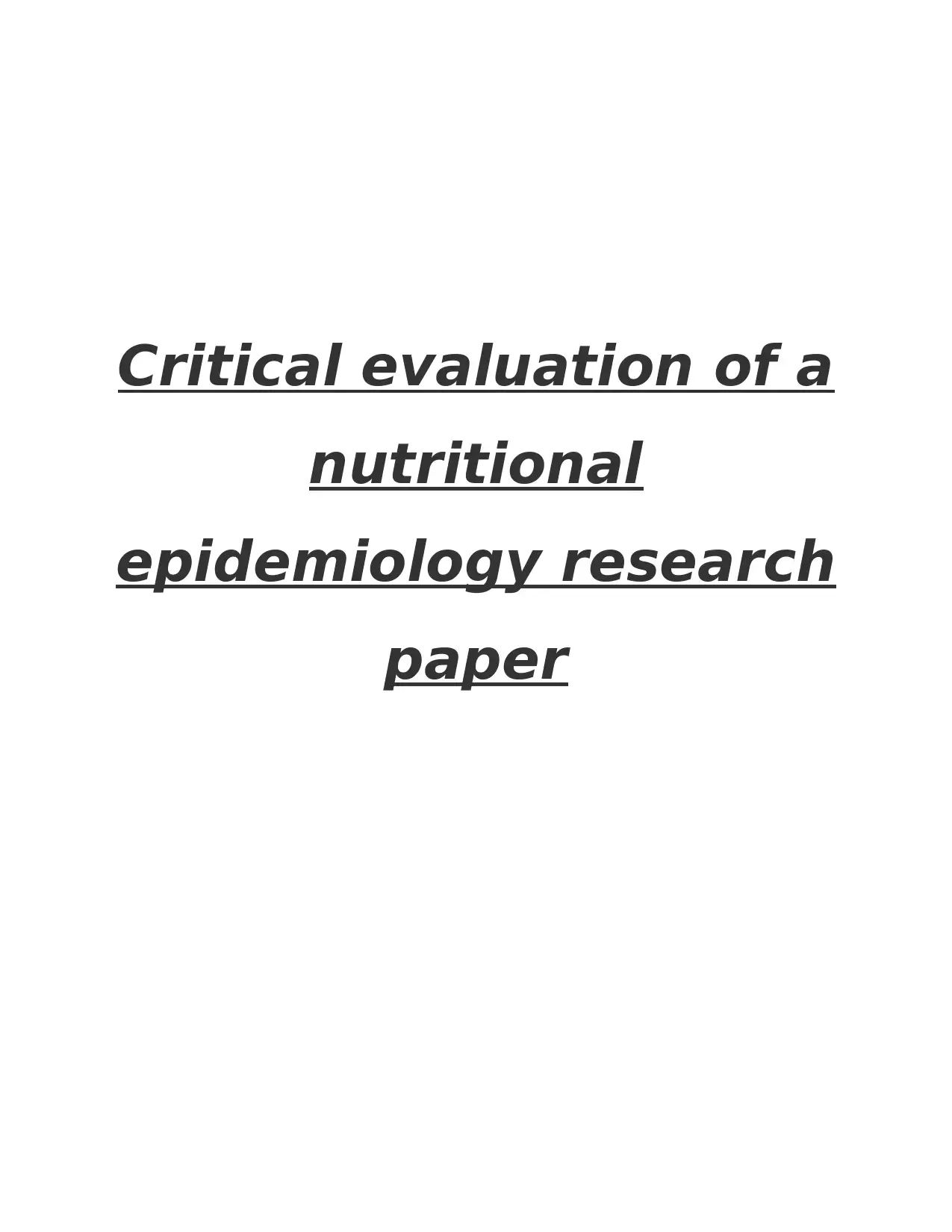
Critical evaluation of a
nutritional
epidemiology research
paper
nutritional
epidemiology research
paper
Paraphrase This Document
Need a fresh take? Get an instant paraphrase of this document with our AI Paraphraser

Table of Contents
Critical evaluation of a nutritional epidemiology of research paper................................................3
REFERENCES................................................................................................................................6
Critical evaluation of a nutritional epidemiology of research paper................................................3
REFERENCES................................................................................................................................6
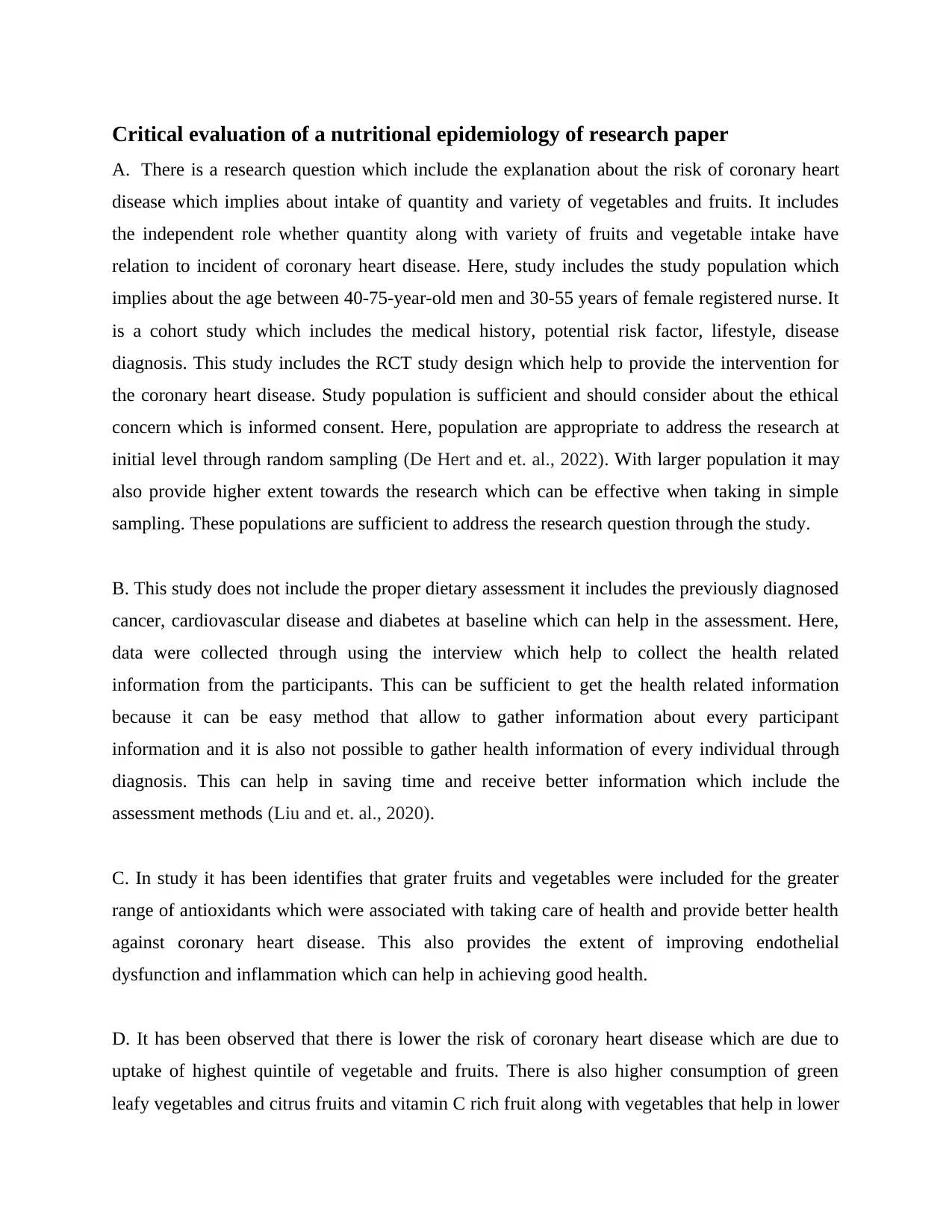
Critical evaluation of a nutritional epidemiology of research paper
A. There is a research question which include the explanation about the risk of coronary heart
disease which implies about intake of quantity and variety of vegetables and fruits. It includes
the independent role whether quantity along with variety of fruits and vegetable intake have
relation to incident of coronary heart disease. Here, study includes the study population which
implies about the age between 40-75-year-old men and 30-55 years of female registered nurse. It
is a cohort study which includes the medical history, potential risk factor, lifestyle, disease
diagnosis. This study includes the RCT study design which help to provide the intervention for
the coronary heart disease. Study population is sufficient and should consider about the ethical
concern which is informed consent. Here, population are appropriate to address the research at
initial level through random sampling (De Hert and et. al., 2022). With larger population it may
also provide higher extent towards the research which can be effective when taking in simple
sampling. These populations are sufficient to address the research question through the study.
B. This study does not include the proper dietary assessment it includes the previously diagnosed
cancer, cardiovascular disease and diabetes at baseline which can help in the assessment. Here,
data were collected through using the interview which help to collect the health related
information from the participants. This can be sufficient to get the health related information
because it can be easy method that allow to gather information about every participant
information and it is also not possible to gather health information of every individual through
diagnosis. This can help in saving time and receive better information which include the
assessment methods (Liu and et. al., 2020).
C. In study it has been identifies that grater fruits and vegetables were included for the greater
range of antioxidants which were associated with taking care of health and provide better health
against coronary heart disease. This also provides the extent of improving endothelial
dysfunction and inflammation which can help in achieving good health.
D. It has been observed that there is lower the risk of coronary heart disease which are due to
uptake of highest quintile of vegetable and fruits. There is also higher consumption of green
leafy vegetables and citrus fruits and vitamin C rich fruit along with vegetables that help in lower
A. There is a research question which include the explanation about the risk of coronary heart
disease which implies about intake of quantity and variety of vegetables and fruits. It includes
the independent role whether quantity along with variety of fruits and vegetable intake have
relation to incident of coronary heart disease. Here, study includes the study population which
implies about the age between 40-75-year-old men and 30-55 years of female registered nurse. It
is a cohort study which includes the medical history, potential risk factor, lifestyle, disease
diagnosis. This study includes the RCT study design which help to provide the intervention for
the coronary heart disease. Study population is sufficient and should consider about the ethical
concern which is informed consent. Here, population are appropriate to address the research at
initial level through random sampling (De Hert and et. al., 2022). With larger population it may
also provide higher extent towards the research which can be effective when taking in simple
sampling. These populations are sufficient to address the research question through the study.
B. This study does not include the proper dietary assessment it includes the previously diagnosed
cancer, cardiovascular disease and diabetes at baseline which can help in the assessment. Here,
data were collected through using the interview which help to collect the health related
information from the participants. This can be sufficient to get the health related information
because it can be easy method that allow to gather information about every participant
information and it is also not possible to gather health information of every individual through
diagnosis. This can help in saving time and receive better information which include the
assessment methods (Liu and et. al., 2020).
C. In study it has been identifies that grater fruits and vegetables were included for the greater
range of antioxidants which were associated with taking care of health and provide better health
against coronary heart disease. This also provides the extent of improving endothelial
dysfunction and inflammation which can help in achieving good health.
D. It has been observed that there is lower the risk of coronary heart disease which are due to
uptake of highest quintile of vegetable and fruits. There is also higher consumption of green
leafy vegetables and citrus fruits and vitamin C rich fruit along with vegetables that help in lower
⊘ This is a preview!⊘
Do you want full access?
Subscribe today to unlock all pages.

Trusted by 1+ million students worldwide
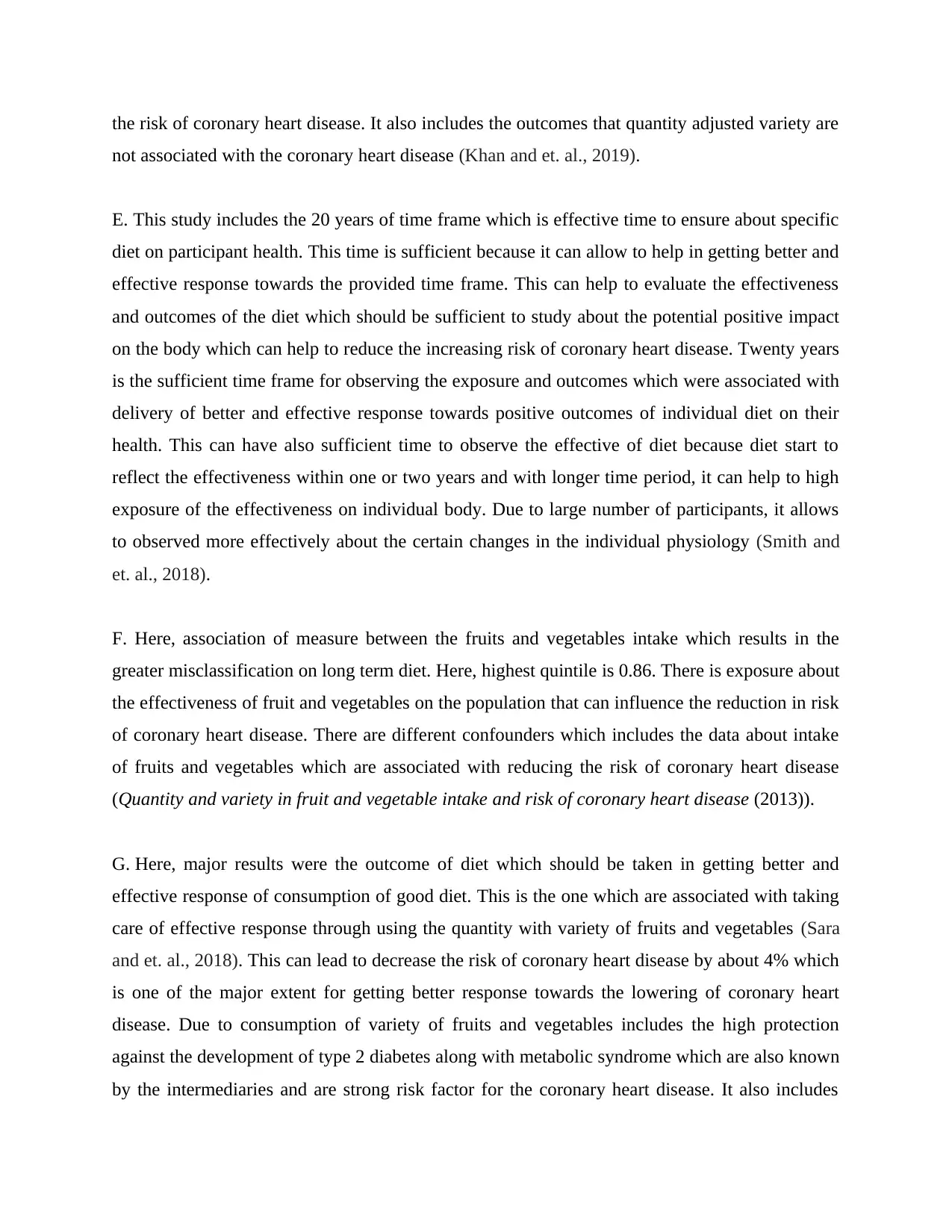
the risk of coronary heart disease. It also includes the outcomes that quantity adjusted variety are
not associated with the coronary heart disease (Khan and et. al., 2019).
E. This study includes the 20 years of time frame which is effective time to ensure about specific
diet on participant health. This time is sufficient because it can allow to help in getting better and
effective response towards the provided time frame. This can help to evaluate the effectiveness
and outcomes of the diet which should be sufficient to study about the potential positive impact
on the body which can help to reduce the increasing risk of coronary heart disease. Twenty years
is the sufficient time frame for observing the exposure and outcomes which were associated with
delivery of better and effective response towards positive outcomes of individual diet on their
health. This can have also sufficient time to observe the effective of diet because diet start to
reflect the effectiveness within one or two years and with longer time period, it can help to high
exposure of the effectiveness on individual body. Due to large number of participants, it allows
to observed more effectively about the certain changes in the individual physiology (Smith and
et. al., 2018).
F. Here, association of measure between the fruits and vegetables intake which results in the
greater misclassification on long term diet. Here, highest quintile is 0.86. There is exposure about
the effectiveness of fruit and vegetables on the population that can influence the reduction in risk
of coronary heart disease. There are different confounders which includes the data about intake
of fruits and vegetables which are associated with reducing the risk of coronary heart disease
(Quantity and variety in fruit and vegetable intake and risk of coronary heart disease (2013)).
G. Here, major results were the outcome of diet which should be taken in getting better and
effective response of consumption of good diet. This is the one which are associated with taking
care of effective response through using the quantity with variety of fruits and vegetables (Sara
and et. al., 2018). This can lead to decrease the risk of coronary heart disease by about 4% which
is one of the major extent for getting better response towards the lowering of coronary heart
disease. Due to consumption of variety of fruits and vegetables includes the high protection
against the development of type 2 diabetes along with metabolic syndrome which are also known
by the intermediaries and are strong risk factor for the coronary heart disease. It also includes
not associated with the coronary heart disease (Khan and et. al., 2019).
E. This study includes the 20 years of time frame which is effective time to ensure about specific
diet on participant health. This time is sufficient because it can allow to help in getting better and
effective response towards the provided time frame. This can help to evaluate the effectiveness
and outcomes of the diet which should be sufficient to study about the potential positive impact
on the body which can help to reduce the increasing risk of coronary heart disease. Twenty years
is the sufficient time frame for observing the exposure and outcomes which were associated with
delivery of better and effective response towards positive outcomes of individual diet on their
health. This can have also sufficient time to observe the effective of diet because diet start to
reflect the effectiveness within one or two years and with longer time period, it can help to high
exposure of the effectiveness on individual body. Due to large number of participants, it allows
to observed more effectively about the certain changes in the individual physiology (Smith and
et. al., 2018).
F. Here, association of measure between the fruits and vegetables intake which results in the
greater misclassification on long term diet. Here, highest quintile is 0.86. There is exposure about
the effectiveness of fruit and vegetables on the population that can influence the reduction in risk
of coronary heart disease. There are different confounders which includes the data about intake
of fruits and vegetables which are associated with reducing the risk of coronary heart disease
(Quantity and variety in fruit and vegetable intake and risk of coronary heart disease (2013)).
G. Here, major results were the outcome of diet which should be taken in getting better and
effective response of consumption of good diet. This is the one which are associated with taking
care of effective response through using the quantity with variety of fruits and vegetables (Sara
and et. al., 2018). This can lead to decrease the risk of coronary heart disease by about 4% which
is one of the major extent for getting better response towards the lowering of coronary heart
disease. Due to consumption of variety of fruits and vegetables includes the high protection
against the development of type 2 diabetes along with metabolic syndrome which are also known
by the intermediaries and are strong risk factor for the coronary heart disease. It also includes
Paraphrase This Document
Need a fresh take? Get an instant paraphrase of this document with our AI Paraphraser
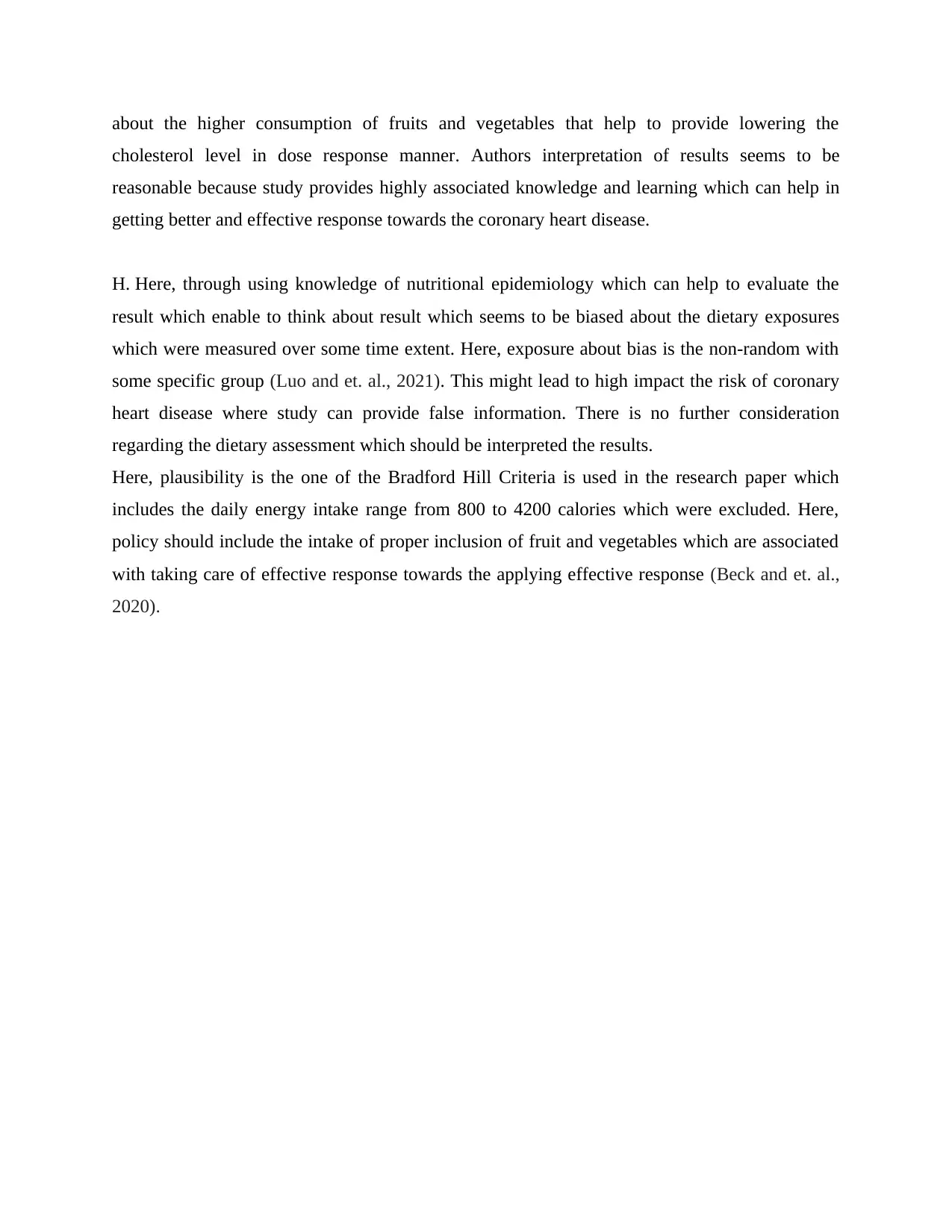
about the higher consumption of fruits and vegetables that help to provide lowering the
cholesterol level in dose response manner. Authors interpretation of results seems to be
reasonable because study provides highly associated knowledge and learning which can help in
getting better and effective response towards the coronary heart disease.
H. Here, through using knowledge of nutritional epidemiology which can help to evaluate the
result which enable to think about result which seems to be biased about the dietary exposures
which were measured over some time extent. Here, exposure about bias is the non-random with
some specific group (Luo and et. al., 2021). This might lead to high impact the risk of coronary
heart disease where study can provide false information. There is no further consideration
regarding the dietary assessment which should be interpreted the results.
Here, plausibility is the one of the Bradford Hill Criteria is used in the research paper which
includes the daily energy intake range from 800 to 4200 calories which were excluded. Here,
policy should include the intake of proper inclusion of fruit and vegetables which are associated
with taking care of effective response towards the applying effective response (Beck and et. al.,
2020).
cholesterol level in dose response manner. Authors interpretation of results seems to be
reasonable because study provides highly associated knowledge and learning which can help in
getting better and effective response towards the coronary heart disease.
H. Here, through using knowledge of nutritional epidemiology which can help to evaluate the
result which enable to think about result which seems to be biased about the dietary exposures
which were measured over some time extent. Here, exposure about bias is the non-random with
some specific group (Luo and et. al., 2021). This might lead to high impact the risk of coronary
heart disease where study can provide false information. There is no further consideration
regarding the dietary assessment which should be interpreted the results.
Here, plausibility is the one of the Bradford Hill Criteria is used in the research paper which
includes the daily energy intake range from 800 to 4200 calories which were excluded. Here,
policy should include the intake of proper inclusion of fruit and vegetables which are associated
with taking care of effective response towards the applying effective response (Beck and et. al.,
2020).
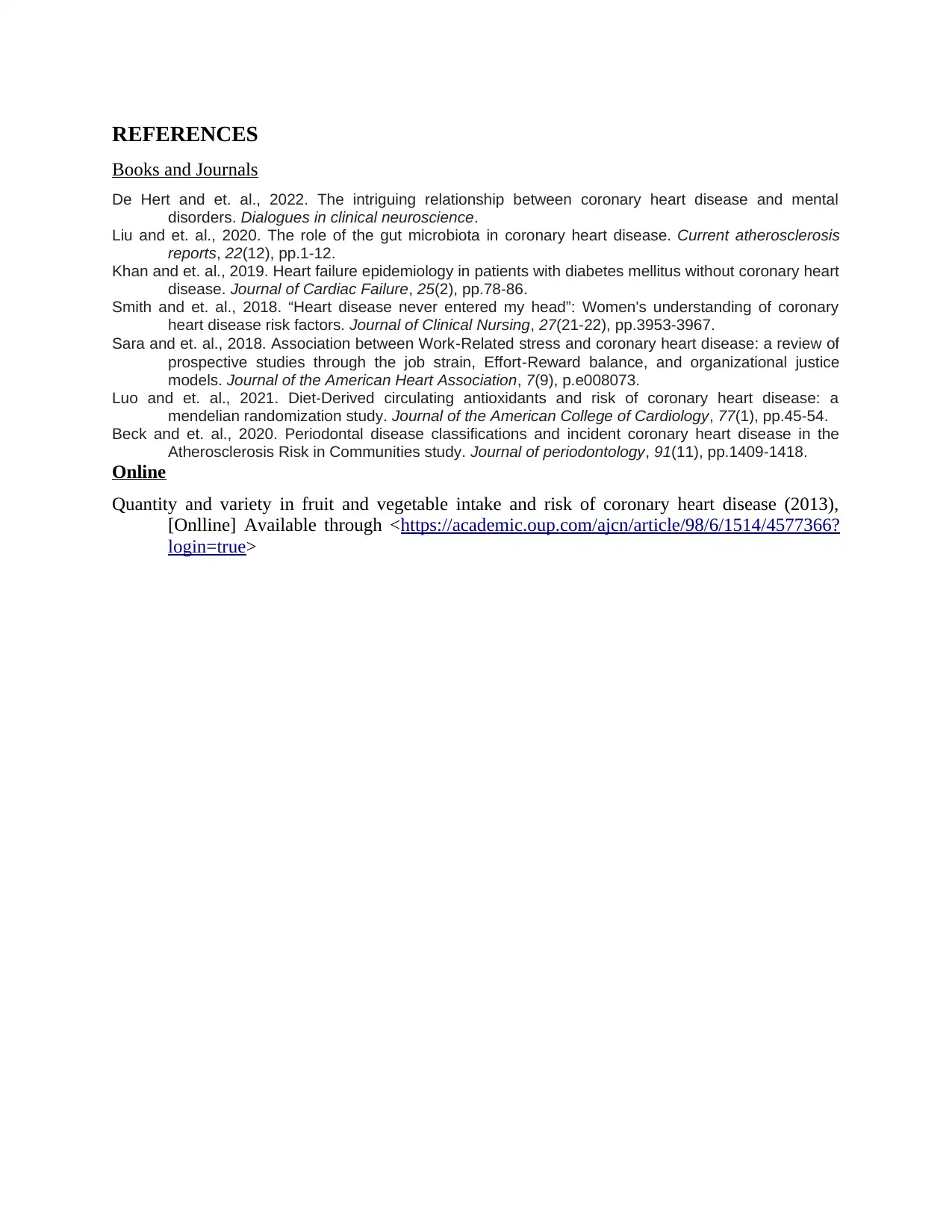
REFERENCES
Books and Journals
De Hert and et. al., 2022. The intriguing relationship between coronary heart disease and mental
disorders. Dialogues in clinical neuroscience.
Liu and et. al., 2020. The role of the gut microbiota in coronary heart disease. Current atherosclerosis
reports, 22(12), pp.1-12.
Khan and et. al., 2019. Heart failure epidemiology in patients with diabetes mellitus without coronary heart
disease. Journal of Cardiac Failure, 25(2), pp.78-86.
Smith and et. al., 2018. “Heart disease never entered my head”: Women's understanding of coronary
heart disease risk factors. Journal of Clinical Nursing, 27(21-22), pp.3953-3967.
Sara and et. al., 2018. Association between Work‐Related stress and coronary heart disease: a review of
prospective studies through the job strain, Effort‐Reward balance, and organizational justice
models. Journal of the American Heart Association, 7(9), p.e008073.
Luo and et. al., 2021. Diet-Derived circulating antioxidants and risk of coronary heart disease: a
mendelian randomization study. Journal of the American College of Cardiology, 77(1), pp.45-54.
Beck and et. al., 2020. Periodontal disease classifications and incident coronary heart disease in the
Atherosclerosis Risk in Communities study. Journal of periodontology, 91(11), pp.1409-1418.
Online
Quantity and variety in fruit and vegetable intake and risk of coronary heart disease (2013),
[Onlline] Available through <https://academic.oup.com/ajcn/article/98/6/1514/4577366?
login=true>
Books and Journals
De Hert and et. al., 2022. The intriguing relationship between coronary heart disease and mental
disorders. Dialogues in clinical neuroscience.
Liu and et. al., 2020. The role of the gut microbiota in coronary heart disease. Current atherosclerosis
reports, 22(12), pp.1-12.
Khan and et. al., 2019. Heart failure epidemiology in patients with diabetes mellitus without coronary heart
disease. Journal of Cardiac Failure, 25(2), pp.78-86.
Smith and et. al., 2018. “Heart disease never entered my head”: Women's understanding of coronary
heart disease risk factors. Journal of Clinical Nursing, 27(21-22), pp.3953-3967.
Sara and et. al., 2018. Association between Work‐Related stress and coronary heart disease: a review of
prospective studies through the job strain, Effort‐Reward balance, and organizational justice
models. Journal of the American Heart Association, 7(9), p.e008073.
Luo and et. al., 2021. Diet-Derived circulating antioxidants and risk of coronary heart disease: a
mendelian randomization study. Journal of the American College of Cardiology, 77(1), pp.45-54.
Beck and et. al., 2020. Periodontal disease classifications and incident coronary heart disease in the
Atherosclerosis Risk in Communities study. Journal of periodontology, 91(11), pp.1409-1418.
Online
Quantity and variety in fruit and vegetable intake and risk of coronary heart disease (2013),
[Onlline] Available through <https://academic.oup.com/ajcn/article/98/6/1514/4577366?
login=true>
⊘ This is a preview!⊘
Do you want full access?
Subscribe today to unlock all pages.

Trusted by 1+ million students worldwide
1 out of 6
Related Documents
Your All-in-One AI-Powered Toolkit for Academic Success.
+13062052269
info@desklib.com
Available 24*7 on WhatsApp / Email
![[object Object]](/_next/static/media/star-bottom.7253800d.svg)
Unlock your academic potential
Copyright © 2020–2025 A2Z Services. All Rights Reserved. Developed and managed by ZUCOL.





